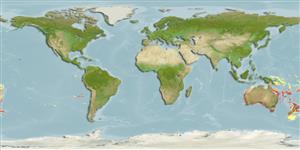>
Gadiformes (Cods) >
Moridae (Morid cods)
Etymology: Physiculus: Diminutive of Greek, physa = tube.
Issue
The gender agreement of the specific epithet needs clarification. Kept as the original name luminosa in Eschmeyer (CofF ver. May 2011: Ref. 86870).
Environment: milieu / climate zone / depth range / distribution range
Ecologia
marinhas batidemersal; intervalo de profundidade 130 - 640 m (Ref. 31777). Deep-water
South Pacific: off South America on the Nasca (Nazca) Ridge, Austral Ridge in central South Pacific, and southwestern Pacific off northern New Zealand and eastern Australia (Queensland and New South Wales). Reported from off New Caledonia.
Tamanho / Peso / Idade
Maturity: Lm ? range ? - ? cm
Max length : 30.0 cm TL macho/indeterminado; (Ref. 9563)
A temperate (Ref. 7300) and benthic species (Ref. 75154) recorded from the upper continental slope (Ref. 9563, 75154).
Life cycle and mating behavior
Maturidade | Reprodução | Desova | Ovos | Fecundidade | Larvas
May, J.L. and J.G.H. Maxwell, 1986. Trawl fish from temperate waters of Australia. CSIRO Division of Fisheries Research, Tasmania. 492 p. (Ref. 9563)
Categoria na Lista Vermelha da IUCN (Ref. 130435: Version 2024-2)
Ameaça para o homem
Harmless
Utilização humana
Ferramentas
Relatórios especiais
Descarregue XML
Fontes da internet
Estimates based on models
Preferred temperature (Ref.
123201): 11.2 - 18.8, mean 13 °C (based on 55 cells).
Phylogenetic diversity index (Ref.
82804): PD
50 = 0.5000 [Uniqueness, from 0.5 = low to 2.0 = high].
Bayesian length-weight: a=0.00389 (0.00192 - 0.00787), b=3.11 (2.93 - 3.29), in cm total length, based on LWR estimates for this (Sub)family-body shape (Ref.
93245).
Nível Trófico (Ref.
69278): 3.4 ±0.4 se; based on size and trophs of closest relatives
Resiliência (Ref.
120179): Médio, tempo mínimo de duplicação da população 1,4 - 4,4 anos (Assuming tmax>3).
Fishing Vulnerability (Ref.
59153): Low vulnerability (20 of 100).
